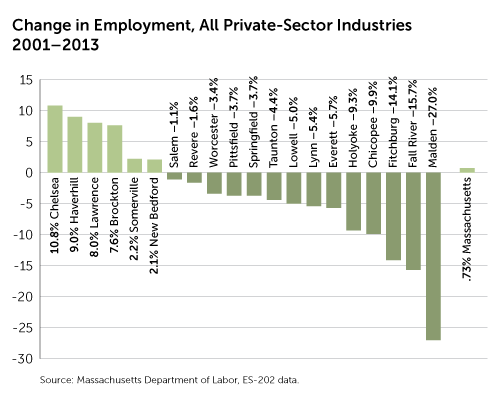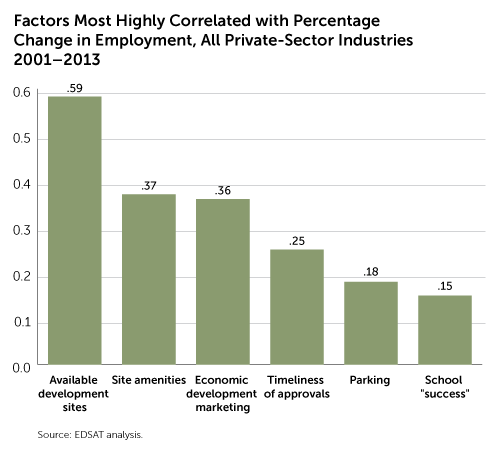What Makes Working Cities Work? 
As some Massachusetts "working cities" are beginning to regain their economic momentum, new evidence highlights important factors contributing to their renaissance.
Cities and towns that fail to retain and attract business are prone to decline, distress, and poverty. Detroit is today's most familiar example, but some formerly prosperous industrial cities in New England also are struggling with disinvestment and job loss. What can such communities do to boost their chances of an economic renaissance?
Regions with rich mineral deposits, a warmer climate, or highly educated workers tend to be more prosperous than cities without such advantages-insights of little comfort to New England's older cities. But a new analysis developed at the Dukakis Center for Urban and Regional Policy at Northeastern University suggests that municipal leaders have several ways to influence their community's economic destiny.
Massachusetts Working Cities
The "working cities" of Massachusetts, as defined by the Boston Fed's Working Cities Challenge, are those with a population greater than 35,000 (excluding Boston), median family income below the median for all Massachusetts cities, and a poverty rate above the statewide city median. Most also have an older industrial base, and the vast majority are "gateway" centers for new immigrants.
All the Working Cities have suffered periods of disinvestment since World War II, but between 2001 and the second quarter of 2013, employment growth rates have differed markedly among them. (See "Change in Employment.") With less than a 1 percent increase in employment statewide during this period, one might have expected to see steep job losses in many of these cities. Surprisingly, six of the Working Cities experienced positive employment growth, with growth rates that exceeded the statewide average.[1]
Economic Development Self-Assessment Tool (EDSAT)
What can explain the divergence in employment success across the different Working Cities? In 2005, Dukakis Center research staff began developing a software tool for local government leaders to assess a community's capacity to attract business investment and create jobs. Using survey and focus-group data collected from experts who help companies make location decisions, the Center learned about business-location deal breakers and deal makers.
Available parking and commercial rents were seen as critical in assessing a site for a new or expanding operation. Experts also frequently mentioned "time to market," and most said that in the globalized, highspeed economy, companies need assurance that they can "get up and running quickly." Processes that slow approvals for development can be deal breakers. Despite conventional wisdom, property tax rates and local tax incentives were considered less important as deal makers.
On the basis of a long list of location factors identified in the research, the Dukakis Center developed a questionnaire for municipal officials. The process was enhanced when municipal leaders invited business and civic leaders to join them in the effort. From the questionnaire, the Center created 26 measures that rank each city and town on a broad range of location factors.
Correlation Analysis
The nearly 80 communities that have already completed EDSAT include 19 of the 20 in the Working Cities Challenge-all but Fall River. Given the small sample size, researchers used simple correlation coefficients to indicate any possible link between city-specific location factors on the one hand and the city's employment growth rate on the other. We arbitrarily selected a correlation coefficient of +.15 or greater to signify a positive relationship between a given EDSAT measure and the 2001-2013 percentage change in employment. Of the 26 location measures, only six met the correlation criterion. (See "Factors Most Highly Correlated with Percentage Change in Employment.")


By far, the measure most highly correlated with employment growth is available development sites, with a correlation coefficient of +.59. The Working Cities that are successful at attracting new employment are those with publicly owned sites available for economic development, industrial land protected from residential encroachment, an active strategy for reclaiming vacant shopping centers and taxing delinquent properties, and either up-to-date lists of existing commercial and industrial sites or active partnerships with property brokers and developers to identify appropriate properties.
The site amenities factor is second in importance, with a correlation coefficient of +.37. Businesses are more likely to opt for sites with nearby fast-food restaurants for their employees, fine-dining options, retail shops, and day-care centers.
In third place is economic development marketing, with a correlation coefficient of +.36. Working Cities with more comprehensive marketing campaigns appear to attract more business investment and jobs. Such campaigns may help change what location experts call the negative cognitive maps employers often have of these older cities.
Timeliness of the municipal approval process for new or expanding firms has the fourth highest correlation coefficient (+.25). This correlation seems to confirm the importance of "time to market."
Available parking for employees and customers also appears to be important (+.18), consistent with the location specialist survey results.
Finally, school "success" met the +.15 cutoff. Those Working Cities that spend more on their public schools and have more successful students appear to have a slight advantage in creating a business environment conducive to greater job growth.
Other factors that come close to meeting our correlation threshold are adequate electric, gas, water, and communications infrastructure (+.14), fast-track permitting (+.14), the cross-marketing of the community to prospective firms by a coordinated effort of both municipal and business leaders (+.13), the use of marketing followup to learn why firms either decided to settle in the municipality or chose to move elsewhere (+.13), and labor force quality as measured by the number of local professionals and well-trained workers (+.13). Each of those was positively correlated with employment growth, suggesting they might have at least a marginal impact on location decisions.
What was unanticipated is the apparent absence of a strong statistical correlation between employment growth and such variables as crime rates (+.07), complementary business services such as law firms and accounting firms (+.07), public transit (+.04) and nearby highway access (-.03). Moreover, within the Working Cities, there turned out to be no variance in labor cost in the EDSAT measure and therefore zero correlation with employment growth.
Even more surprising were factors with relatively large negative coefficients: high traffic congestion (-.23), low local tax rates (-.27), reputed low citizen opposition to development (-.35), and the city's apparent physical attractiveness (-.35). Despite their appearance, less attractive municipalities among the Working Cities appear to have no disadvantage in job creation. Also, lower local tax rates, if anything, contributed to slower employment growth, suggesting the possibility that higher tax levies provide for better public services that companies enjoy.
Three other factors might have something to do with job growth. Proximity to Boston is weakly correlated with employment growth (+.16). Improving access to and from Boston for employees and customers through better transit may be one way to improve the employment prospects of these Working Cities. Cities with the poorest populations among the Working Cities do not appear to be at any special disadvantage when it comes to their ability to retain and attract establishments that provide employment opportunity (+.17). Interestingly, having a higher concentration of manufacturing employment is at least somewhat correlated (+.13) with experiencing faster employment growth over the period under consideration, a finding consistent with evidence from other research by this author that manufacturing is making a comeback in the Commonwealth.
§
Even though there is nothing definitive that we can claim from this analysis given the limited statistical value that we obtain from simple correlation analysis, the results point to factors that appear to be connected to employment growth.
Most intriguing are the relatively high positive correlations we find for measures over which municipal leaders actually have some control. City governments can improve the timeliness of approvals. They can improve economic development marketing. Making development sites available for business and ensuring those sites have a range of amenities appear to be steps cities can take to enhance prosperity. Many of the Working Cities are home to abandoned mills that can and are being converted to new commercial and industrial uses. Providing adequate parking near development sites also can help.
In short, even cities that have experienced severe deindustrialization and are struggling to provide good schools can affect their own economic destiny by improving municipal processes and working to change obsolete impressions through effective marketing. The key seems to be strong municipal leadership, especially when there is a healthy working relationship with the business community.
Barry Bluestone is a senior visiting scholar in the Regional and Community Outreach Department of the Federal Reserve Bank of Boston. He is the Russell B. and Andree B. Stearns Professor of Political Economy at Northeastern University and director of the university's Kitty and Michael Dukakis Center for Urban and Regional Policy. Contact him at b.bluestone@neu.edu.
Endnotes
[1] The percentage change in employment for each Working City is derived from the ES-202 data set compiled from unemployment insurance records filed by companies with the Massachusetts Department of Labor and Workforce Development each quarter. The data refer to the number of employees working in companies in each city regardless of where the workers themselves reside. Therefore, increased employment does not necessarily benefit residents of the Working Cities where the companies are physically located.
[Back to story]
Articles may be reprinted if Communities & Banking and the author are credited and the following disclaimer is used: "The views expressed are not necessarily those of the Federal Reserve Bank of Boston or the Federal Reserve System. Information about organizations and upcoming events is strictly informational and not an endorsement."

 About the Authors
About the Authors
Barry Bluestone

 Resources
Resources
Related Content
A New Vision for Workforce Preparation
Making racial equity integral to all aspects of the Working Cities Challenge
The COVID-19 recession: Why it’s different, what that means for cities, service workers, education
Leveraging Financial Education to Improve the Impact of Workforce Innovation and Opportunity Act (WIOA)



